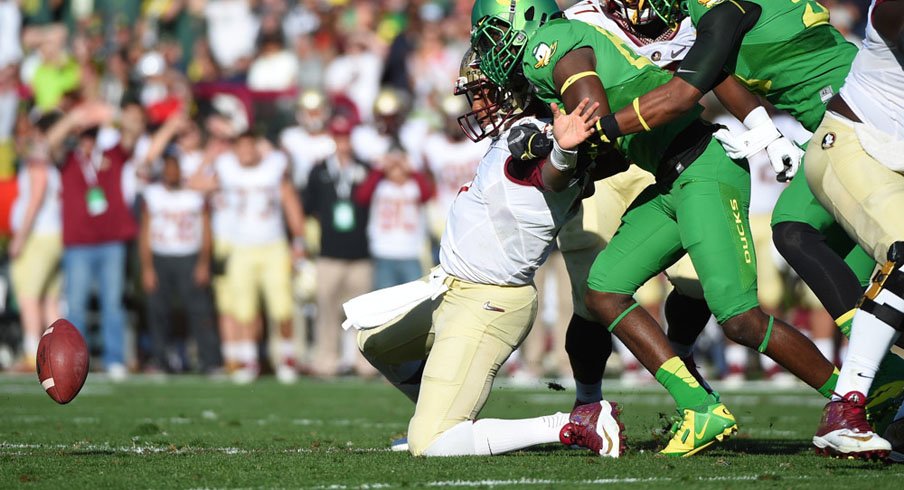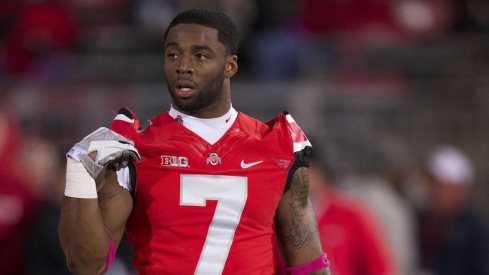On paper, a matchup between Ohio State's offense and Oregon's defense looks salivating. The Ducks' defense allows 421.9 yards of offense a game, 86th in the country. It's 111th in the country against the pass (265.9 yards per game) and 51st in the country against the run (156 yards per game).
Ohio State just hung 537 yards of offense on Alabama and put 558 yards of offense on Wisconsin, all with its third-string quarterback for the season. The Buckeyes scored a combined 87 points of offense against the no. 4 defense (Wisconsin) and no. 12 defense (Alabama).
In short, Ohio State fans are expecting the offense to run wild over Oregon's defense even if it fears Oregon's offense may do the same to Ohio State's defense. While Ohio State's offense may (and hopefully will) exceed those expectations, the aggregate numbers belie the nature of Oregon's defense and its team as a whole.
Oregon's overall philosophy appears to be predicated on front-running. That is, Oregon is so assured of its offensive prowess that it believes it can afford to concede yards on defense during the game, and doesn't care if it does later in the game when victory is certain. Perhaps this program, since Chip Kelly took it over in 2009, is the best front-running football program that college football fans have seen to date.
It's why Oregon's team is so eager to go for two points after the game's first touchdown. Oregon believes it can afford to do it, that it will convert, and that teams it plays are unable to keep pace with it. For the most part this season, that confidence in itself has been vindicated.
This also illuminates why Oregon's overall defensive stats are so poor. Take, for example, Oregon's supposedly meager passing defense. In the first half of games, Oregon's defense is averaging only 126.78 yards of offense through the air. The pass defense rating is 32nd in the country. This is impressive considering Oregon is next to last in the country in first-half pass attempts against it. Teams are completing 59.9-percent of passes against Oregon in the first half, which is tied for 76th in the country with Temple. Teams in the first half have just seven passing touchdowns against Oregon to Oregon's five first-half interceptions.
In short, Oregon looks above average, or even quite good, against the pass in the first half.
Its offense also looks incredible in first halves of games, routinely creating double-digit deficits for opposing teams at intermission. Entering the fourth quarter, the game is almost out of reach for the opponent. This puts the opposing offense in a position where it feels the need to throw the ball to keep pace.
Oregon's second-half passing defense suffers for it. In the second half of games this season, Oregon is next to last in the country in pass defense rating. Teams complete just over 60-percent their second half passes against Oregon (95th in the country). Oregon also conceded 13 second-half passing touchdowns (109th in the country) to intercepting seven passes.

These numbers get even worse when isolating situations in which teams are leading by 15 or more points. Oregon is last in the country in pass yards conceded when leading by more than two touchdowns.
This complicates Oregon's aggregate totals for the game and make it seem poor overall. This would belie the actual quality of Oregon's defense. Oregon's offense puts its defense in situations where teams throw more against it. Oregon's defense, for its part, is content to concede these yards, even points, when assured of the ability of its offense to score at will.
Oregon's rush defense tells a similar tale. Oregon is 86th in the country in yards allowed on the ground in the first half, allowing around 84 yards on the ground in the first half. This would put Oregon at 73rd in the country in yards per carry. It has also allowed nine runs of more than 20 yards in the first half, which is 65th in the country.
This is curious because Oregon plays a lot of pass-happy teams. For example, Washington State is last in the country in rushing offense (39.83 yards per game), but the Cougars had two guys rush for a combined 69 yards on 16 carries in their meeting in September. Be mindful that the scale here is a Mike Leach offense. The equivalent might be two guys on any other team having 100-yard days each.
| Category | Value | Rank |
|---|---|---|
| RUSHING YARDS ALLOWED | 2,185 | 49th |
| PASSING YARDS ALLOWED | 3,434 | 108th |
| TOTAL DEFENSE | 5,907 | 84th |
| PASS EFFICIENCY DEFENSE | 123.59 | 50th |
| SCORING DEFENSE | 22.3 | 27th |
| FUMBLES RECOVERED | 18 | 3rd |
| INTERCEPTIONS | 12 | T-53rd |
| TURNOVER MARGIN | 1.43 | 2nd |
| SACKS | 36 | 33rd |
| TACKLES FOR LOSS | 89 | 49th |
| 3rd DOWN DEFENSE | .416 | 82nd |
| 1st DOWNS ALLOWED | 321 | 119th |
| RED ZONE DEFENSE | .833 | T-66th |
| DEFENSIVE TOUCHDOWNS | 2 | T-41st |
Oregon State is 113rd in the country in rushing offense, but Storm Woods tallied 128 yards on the ground in the Civil War game. Florida State is 98th in the country in rushing offense, though Dalvin Cook and Karlos Williams combined for 183 yards on 27 carries. California is 87th in the country in rushing offense but put 193 yards of rushing offense on Oregon.
Things improve in the second half of games. Oregon concedes just 72 second-half rushing yards at about 3.91 yards per carry. This latter statistic put the Ducks at 40th in the country. The eight second-half rushing touchdowns conceded is tied for 29th in the country. This follows both second-half adjustments and the bind in which Oregon's offense places its opponents. Teams pass more, and for more yards, and run less.
Ohio State may well put points and yards on Oregon's defense, but the overall premise is to make sure Oregon's offense doesn't do the same. This seems almost like a truism, but it suggests a bigger point. Oregon, assured of its offensive prowess, is all too eager to front-run. It's been a successful strategy to this point given the explosive nature of its offense. Oregon's defense doesn't care if it allows for more points and yards in the second half of games when Oregon is already leading by two or more touchdowns.
Should Ohio State want to make the most of whatever Oregon's exact deficiencies are on defense, its own defense will have to stop Oregon early. Make Oregon's offense play catch-up because Oregon's team thrives on making its opposing offenses do the same.


